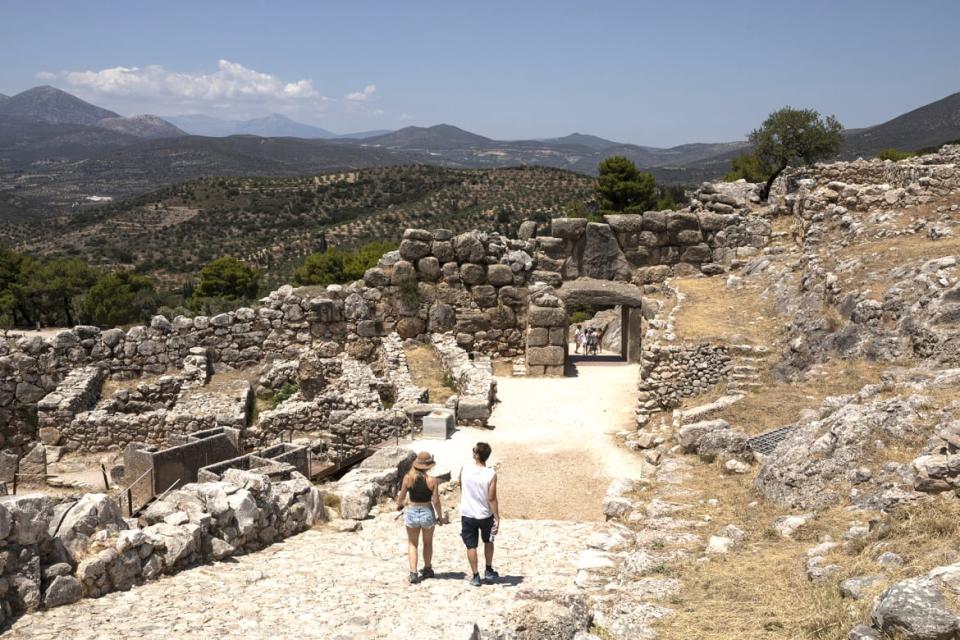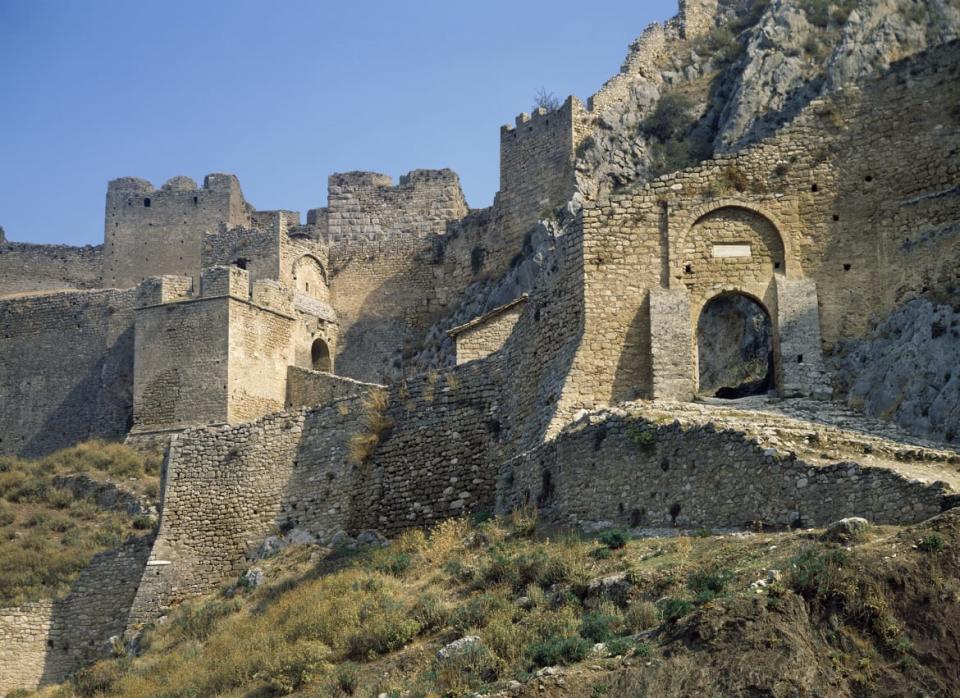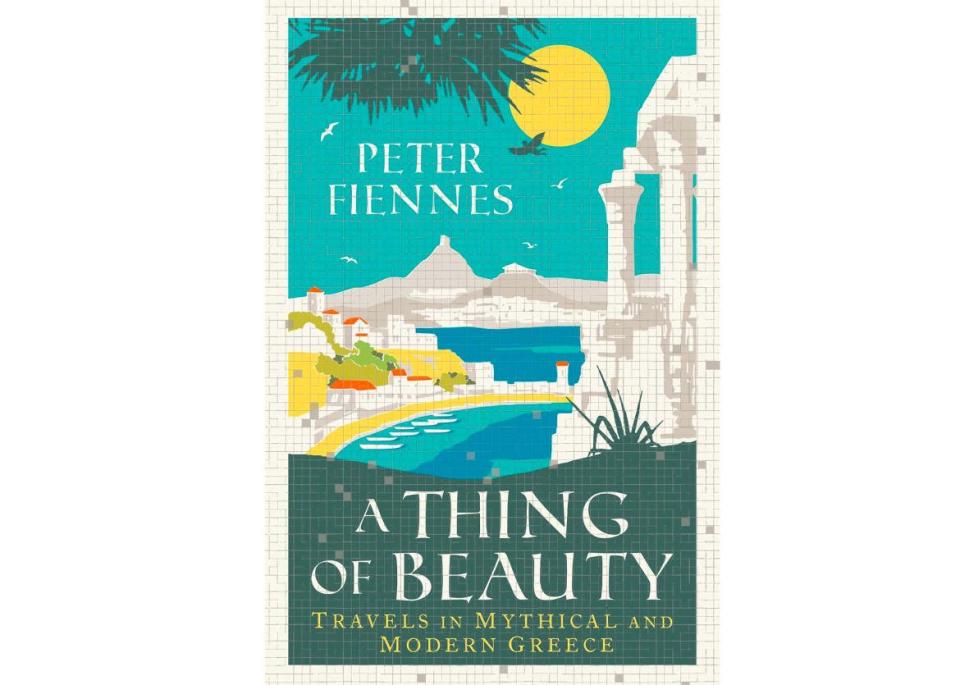These Places From Greek Mythology Still Exist—and You Can Visit

There was once a man in Greece who longed to build himself an immense banqueting hall, where he could sit and feast all day and night. So he went to the sacred grove, where the tallest trees grew, and he and his servants swung their axes, until the nymphs who lived there begged him to stop, because when their trees died, so did they. But the man would not step away, not even when he reached the largest, most sacred tree of all, and the goddess of the harvests, Demeter herself, appeared to warn him not to touch it.
“You have enough,” she said.
He felled the tree anyway, and that night Demeter sent Hunger to him, a creeping, emaciated being that latched onto the man’s open mouth, and breathed an unassuageable need for food into his stomach and guts and deep into his veins. The man woke hungry, and started eating, and called out for food, and more food, but however much he ate, it was never going to be enough. He consumed everything in the house, his horses too, corn, mules, wheat, bread, fruit, even the house cat. And then, at last, with his estate in ruins and his stomach burning, lusting for food he didn’t need, useless, empty, ceaseless consumption, when everything else was gone, the man had no choice but to eat himself.
This all took place a long time ago (no one knows when). In fact, like all these ancient stories, there is more than one version. The myths are slippery and change their shapes and meaning, to suit each age, although the message of this one seems clear… and uncomfortably topical. What we do know is that the man’s name was Erysichthon, and he was a king (or perhaps a prince) and he lived in Thessaly, a region in north eastern Greece that is still lushly forested, at least in parts, despite centuries of intensifying exploitation.
It is thrilling to be able to visit the places where the Greek myths emerged. Of course, the stories were just as often swept in from outside Greece, or brought back, or merged and cross-pollinated with other stories from other places. But you can still visit Mycenae, the city of gold, and stand at the Lion Gate in the place where King Agamemnon stood after his return from Troy, and imagine his wife, Clytemnestra, greeting him with smiles and murder in her heart. Or you can clamber to the top of the ruins of Tiryns, whose walls were built by Cyclopes. Of course they were, because how else could the immense honeycombed slabs have been slotted together, if not with the irresistible muscle power of one-eyed monsters?

Tourists walk towards the Lion Gate of Mycenae at the archaeological site of Mycenae, Greece, on Monday July 27, 2020.
The tortured topography of Greece, with its towering mountains and isolated valleys, means that everything is impossibly local. The fragmented terrain is said to be why the ancient Greek style of fighting emerged, and why they spent so much time at sea, and why their main foodstuffs were olives and fish, and why when the population grew they left to form colonies in other, less aggravating landscapes. Thebes and Athens are just a day’s walk apart, and yet (like every city of the ancient Greek world) they had their own stories and founding legends, even if they shared a pantheon of Olympian gods.
You can visit Corinth, even today, and climb to the summit of the citadel high above the old city (taking in the views to the Gulf of Megara far below, with its canal and the distant rumble of the modern town), and you can sit in the ruins of the temple of Aphrodite, just a stone’s throw from the sacred spring that erupted when Pegasus, the flying horse, struck the ground with his hoof. It is all still there. Oedipus was in Corinth, living happily with the people he thought were his parents, before he set out for Thebes hoping to avoid his fate. And gazing down from these heights, you can see the route that Theseus took by foot, from his home in Troezen, a young man setting out to meet his father for the first time, King Aegeus of Athens. While he was at it, Theseus cleared the route of murderous bandits, so I suppose we have him to thank for the ease with which we can now cruise along the glittering coast.

Medieval fortifications superimposed on the older ones on the Acrocorinth, the acropolis of Corinth, Greece, 6th-17th century.
A short way west from Corinth is the village of Sicyon, once known as Mecone. It was here that Prometheus and Zeus came to an agreement about which parts of an animal should be sacrificed to the gods, and which retained by people for their own consumption. Prometheus tricked Zeus into choosing the bones, and we got the steaks and chops and ribs and the deliciously damp offal, much to the god’s irritation, although you do have to wonder how the all-seeing one could have been deceived. Still, it is magical to stand by the scattered ruins of the amphitheater and consider the paradox. Because it may also be that this is the place where Zeus asked Prometheus to fashion the first humans out of clay. The Greeks had several versions of humanity to account for, but this is possibly be where it all began. At least, that’s what the people who happened to live in this particular place liked to claim. Other versions are available…
On my most recent visit to Greece, I went looking for hope. Specifically, I thought I might be able to track down the spirit of Hope, who was trapped in Pandora’s jar (it was never a box). Maybe that also happened here, in Sicyon, when the beautiful Pandora opened her jar, a gift from Zeus for humanity (“don’t open it”), and all the horrors of the world flew out. Only Hope remained. Until that time there had been no disease, or hunger, or war… and now look at us. Hope, they say, was left behind as consolation for the loss of our innocent paradise, although others have wondered whether Hope wasn’t the cruelest punishment of them all. It is false hope, they reckon, that keeps us from taking responsibility for our own lives.
Even so, in the first year of Covid, and with so much of the world on fire, I went to Greece, looking for hope. My journey took me all over this radiant land, with its wondrous beaches and pine forests and unavoidable salads. Was there anything in the myths, I wondered, that could offer a solution to our present predicament… the sin of Erysichthon… our unassuageable hunger for more? I even consulted the Oracle at Delphi. Where can I find Pandora’s Hope, I wondered? Greece is a land drenched in myth. Although the truth is that it was the brave and inspiring people I met, very much alive today, who gave me my answer.

A Thing of Beauty: Travels in Mythical and Modern Greece, by Peter Fiennes, is published in the US by Oneworld Publications on Nov. 30, 2021.
Get our top stories in your inbox every day. Sign up now!
Daily Beast Membership: Beast Inside goes deeper on the stories that matter to you. Learn more.

 Yahoo Movies
Yahoo Movies 